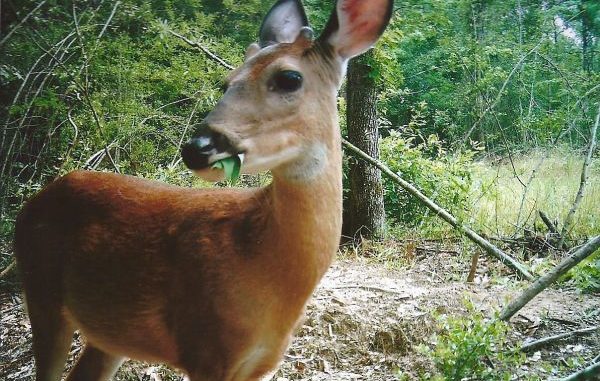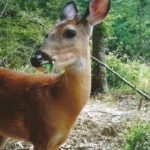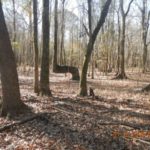
Deer browsing is good, just like the fishing
Last month I wrote about browse surveys and that now is the time to be looking at the deer habitat, seeing first-hand what is available for deer to eat and discovering exactly what plants they are actually eating.
Much of wildlife management, whether it be game or fish, is about age and growth. Is deer body growth and antler development in line with management goals or even exceeding expectations? Likewise, are the bass growing annually, with some reaching that magical lunker category?
I took my own advice and conducted a couple of browse surveys; one on a 1,200-acre site in the Morganza Floodway and the other on the 60-acre Clinton site.
These are two completely different habitat sites: The Morganza tract is a bottomland hardwood forest with surrounding agriculture, and the Clinton tract is a dominant pine forest with surrounding cattle pastures.
Both sites have very good deer populations, and both sites are being managed to produce quality deer, with an expectation that a few will reach trophy status.
Forage plantings are done annually on both tracts but on a much larger scale on the Morganza tract. Both tracts have coyotes and feral hogs, and the Morganza tract is also loaded with black bears— so there are predator populations that can impact the deer management programs, but both tracts have a good deer harvest annually, both bucks and does.
The landowner of the Morganza tract is intensely involved with quality deer management. Deer plantings are done on a large scale, with clover, chicory and soybeans providing excellent forage during the spring and summer growing season. Timber is periodically cut and creates excellent growing conditions for native browse species.
In 2013 there were no acorns and it was a very cold winter, which meant deer were feeding heavily on the winter plantings along with any native plant species that might still be available as browse.
Now, keep in mind that during the fall and winter most of the plant species deer eat during the spring and summer lose their leaves and become dormant, and for the most part are not eaten by deer unless times are really tough.
A few winter browse transects were conducted on the property in February, and deer were heavily browsing the few native species available at that time.
Rubus (aka blackberry) was being hammered hard. On one of the 100-foot transects, 75 bites were found on blackberry.
Basically the only plants available were blackberry, honeysuckle, smilax (or greenbriar) and young oak seedlings that still had some green leaves. With no acorns in the woods, most of the harvest took place in the green patches or on the woods trails leading to these patches.
The spring browse survey I conducted last month on the property found excellent native browse growth.
Trumpet creeper (vine), Smilax (greenbriar vine) and swamp dogwood (native shrub) were the top three species being browsed. Good browsing was also found on elm, oak regeneration, deciduous holly, box elder, blackberry, hackberry and poison ivy
Browse availability was excellent; I found it interesting that blackberry was not being eaten as much as during the winter or like it was in the spring of 2013. However, as already mentioned, the availability of forage plantings such as clover and chicory,is excellent, and deer were feeding on these plants that are high in protein.
Plantings will reduce the browsing activity on the native species, which is exactly what the planting program is designed to do — provide high-quality nutrition that deer can feed on during the growing season.
On the Clinton tract, a browse survey was again done in the 30-acre cutover that is now in its third growing season. Last year the survey found heavy feeding on rubus (blackberry), white oak, water oak, french mulberry, black cherry and hickory.
The survey calculated an average of 32 bites per transect, which is getting a deer population in the high category. The Morganza survey found an average of 24 bites per transect, which also indicates a good population of deer.
Many of the surrounding lands know that the doe harvest is high and believe that too many does are being killed, but the survey does not indicate this.
The doe harvest on the surrounding lands of this small Clinton tract is not in line with the actual deer population (too many deer) and no doubt this 30-acre cutover is pulling the deer in.
Most hunters need to understand that deer are specific feeders and they are fully aware of where the grocery store is on the property they live on. The adjacent piney woods do not have the availability of browse that this cutover does, and consequently the browsing is high.
This year the Clinton survey found heavy browsing on rubus, hickory, water oak, red maple and white oak, with an average of 36 bites per transect. This is higher than in 2013 and again points to the fact that this cutover is a deer magnet.
Logging is done on the surrounding lands; however, the timber management program on these lands involves herbicide treatment of the native plants, and this pretty much eliminates the production of desirable browse species and plants.
A browse survey done on an adjacent tract (10 transects) found a total of seven blackberry plants. Heck, on one transect in the 30-acre cutover there were over 39 bites on blackberry.
If your habitat has what the deer want they will be there, or in this case the deer will come. Last year the harvest on this 60-acre tract was 11 deer, and it could have been higher.
I talked about the elderberry shrub last month, and once again very little elderberry was found on these two properties that have high deer numbers. Elderberry is a highly preferred browse, and deer readily eat it. No elderberry was found in the Clinton survey, and only four plants were found on the Morganza survey.
Elderberry is easily regenerated, and I attribute the lack of this shrub on these two properties to the high deer numbers. Sometimes what you do not see or find on a survey will tell more than what you actually find.
Fish management potpourri
Most of the stories in the Sportsman during the spring and summer are about fishing in this great state, so in keeping with the times I am going to talk a little fishing.
I grew up on Lake Bistineau and spent many a day in pursuit of the largemouth bass. The past couple of years I have been working with my cousin up in Desoto Parish on his property that contains several small lakes and ponds.
In one lake two years ago, I surveyed the fish population and did not find too many bass but lots of bream and mudcats, so we stocked the lake with almost 200 adult bass that were about 1 ½ pounds in size.
We did very little fishing in this lake last year; I did fish an adjacent lake and did quite well with the bass.
It was now time to start fishing this lake and learn what the bass growth and development is since the stocking. While my mother and father probably turned over in their grave when I did this last week, I caught and released five bass that were 4 pounds each (Mom’s and Dad’s mind set was if it gets in the boat it should go in the grease).
It appears that the stocking has worked and we are well on our way to producing some lunker bass
The bream and minnow populations in this lake are excellent; in fact, the bream population needs to be fished hard to keep it in balance and prevent them from getting over-populated.
This is one of the issues that all landowners with fish ponds need to address in their management program. Bream are prolific producers, and they need to be caught and removed.
While it might seem counterproductive, bream provide food for the bass; they likewise can work on the bass spawn and reduce the production of bass, which is what I think was a problem with the lake.
While everyone likes to catch a nice bass, management must take place for bass to reach their potential. So take the kids fishing and fish the bream hard.
Once I finished my bass fishing, I picked up the ultralight rod and, using a small jig with a plastic grub, caught one bluegill after another for two hours — and none were released back into the water.




